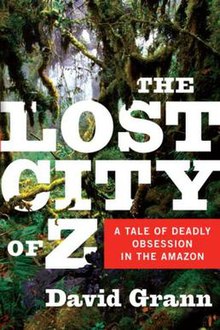The Lost City of Z (book)

First edition cover design
|
|
| Author | David Grann |
|---|---|
| Country | United States |
| Language | English |
| Subject | Percy Fawcett |
| Genre | Non-fiction |
| Publisher | Doubleday |
|
Publication date
|
February 2009 |
| Media type | Print, e-book |
| Pages | 352 |
| ISBN | |
| OCLC | 226038067 |
| 918.1/1046 22 | |
| LC Class | F2546 .G747 2009 |
| Followed by | The Devil and Sherlock Holmes |
The Lost City of Z: A Tale of Deadly Obsession in the Amazon (2009) is the debut non-fiction book by American author David Grann. It tells the story of the British explorer Percy Fawcett who, in 1925, disappeared with his son in the Amazon while looking for an ancient lost city. For decades, explorers and scientists have tried to find evidence of his party and the Lost City of Z. Perhaps as many as 100 people perished or disappeared searching for Fawcett over the years. Grann made his own journey into the Amazon, revealing new evidence about how Fawcett died and showing that Z may have really existed right under his feet.
First in his 2005 article "The Lost City of Z" and later in his full book of the same title, David Grann reported that archaeologist Michael Heckenberger was unearthing a site in the Amazon Xingu region that might be the mysterious lost city. The city was surrounded by not merely a single moat but several in concentric circles, and had palisades much as several nearby tribes described in their folklore. What was more, Heckenberger found evidence of wooden structures and roads that cut through the jungle. There was black Indian earth which showed evidence of people making the infertile soil of the Amazon rich for planting.
Perhaps most intriguing were the direct parallels between the site, referred to as Kuhikugu, and tribes of the area. Pottery methods were still nearly identical, and the tribes followed a diet that prohibited several sources of food—striking considering the long-held belief that such prohibitions would mean death in the harsh rain forest. Even the villages were still laid out in patterns similar to the sites of the ancient cities.
Kuhikugu encompasses more than 20 settlements, each supporting as many as 5,000 people with a remarkable sense of engineering. Though made of wood instead of stone, the society flourished from approximately 200 A.D. until around 1600 according to carbon dating data obtained from the moats and pottery. They built bridges across some of the great rivers of the Amazon, and though they refrained from pyramid structures like the Mayan or Inca, they appear to have preferred to build horizontal monuments.
These people overlapped with the coming of the Europeans to the New World, and in only a few years were so devastated by disease that they virtually died out. The earliest conquistadors saw glimpses of their civilization, but by the time they were able to penetrate the rain forest again the people were all but gone and the jungle was quickly reclaiming the land.
...
Wikipedia
